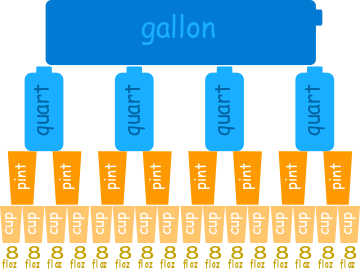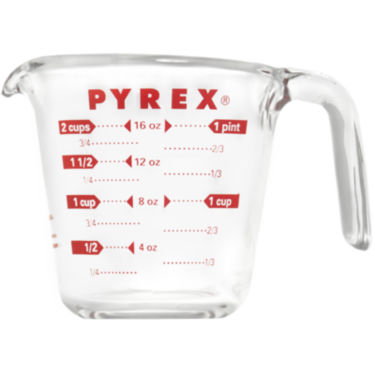Question: What are some common measurements you make in the kitchen?
Volume & Weight: two very common kinds of kitchen measurements are volume and weight.
Volume measures the amount of space a liquid or solid occupies.
Weight measures the amount of substance in a liquid or solid.
Volume Measurements: The U.S. Standard System $$ \begin{array}{|rcl|} \hline 1 \mbox{ tbsp} &=& 3 \mbox{ tsp} \\ \hline 1 \mbox{ cup} &=& 16 \mbox{ tbsp} \\ \hline 1 \mbox{ pt} &=& 2 \mbox{ cup} \\ \hline 1 \mbox{ qt} &=& 2 \mbox{ pt} \\ \hline 1 \mbox{ gal} &=& 4 \mbox{ qt} \\ \hline \end{array} $$
Weight Measurements: The U.S. Standard System
The standard unit of weight in the U.S. Standard System is the pound (abbreviated $\mbox{lb}$).
A pound is subdivided into units of ounces (abbreviated $\mbox{oz}$). That is: $$1 \mbox{ lb}= 16 \mbox{ oz}.$$
Another Volume Measurement: The Fluid Ounce $$ \begin{array}{|rcl|} \hline 1 \mbox{ tsp} &=& \frac{1}{6} \mbox{ fl oz} \\ \hline 1 \mbox{ tbsp} &=& \frac{1}{2} \mbox{ fl oz} \\ \hline 1 \mbox{ cup} &=& 8 \mbox{ fl oz} \\ \hline 1 \mbox{ pt} &=& 16 \mbox{ fl oz} \\ \hline 1 \mbox{ qt} &=& 32 \mbox{ fl oz} \\ \hline 1 \mbox{ gal} &=& 128 \mbox{ fl oz} \\ \hline \end{array} $$
Visualizing U.S. Customary Units


Dire Warning (Part 1): An ounce is not the same as a fluid ounce!
Brownie Point Opportunity: What's the difference?
Points of Confusion: fluid ounces are often simply abbreviated as $\mbox{oz}.$

Dire Warning (Part 2): In the food-service industry the word "ounces" is often used for "fluid ounces" with the understanding that you know the difference.
Result: For the novice, this could could have disastrous consequences in the kitchen.
Note: In this class we will always use $\mbox{fl oz}$ to abbreviate fluid ounces and $\mbox{oz}$ to abbreviate ounces.
Big Fact: the only time you may truly interchange "ounces" and "fluid ounces" is when you are measuring water. That is, $1$ fluid ounce of water truly does equal $1$ ounce of water. (Therefore, for water, $16$ fluid ounces equals a pound.)
When measuring anything else, you could be either slightly off (in the case of water-like liquids), or WAAAAAAAAAAAY OFF (in the case of honey, flour, chopped parsley, etc.)
In Chapter 6 we will learn how to handle converting between ounces and fluid ounces when measuring other things.

A BIG Theme in this Course: Unit Conversions
Example: How many fluid ounces are in $2\frac{1}{2}$ quarts?
The Bridge Method: A preview.
$$ \frac{2.5 \mbox{ qt}}{1} \cdot \frac{32 \mbox{ fl oz}}{1 \mbox{ qt}}=2.5 \cdot 32 \mbox{ fl oz}= 80 \mbox{ fl oz}$$
Example: You have $7$ tablespoons of flour. What percent of a cup do you have?
Hint: convert tablespoons to cups. Then convert the resulting number to a percent.
Another Common Kitchen Measurement: Portion Scoops
Portion scoops measure out common portions and have a numbering system which reflects the number of scoops needed to make $32$ fluid ounces ($1$ quart).
To convert scoops to fluid ounces, simply divide the $32$ by the scoop number.
Example: What is the difference, in fluid ounces, between a number $10$ scoop and a number $20$ scoop?
One Final Bit of Wisdom: When accuracy is important, professional kitchens often prefer weight measurements to volume measurements.